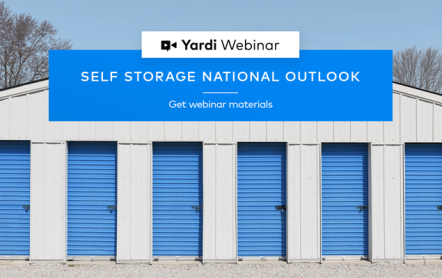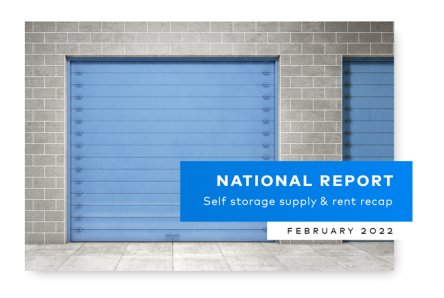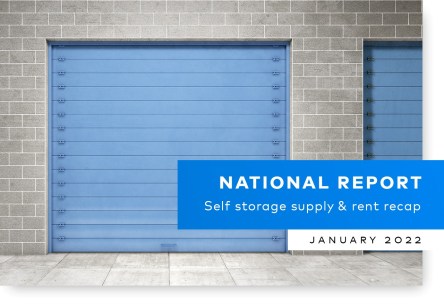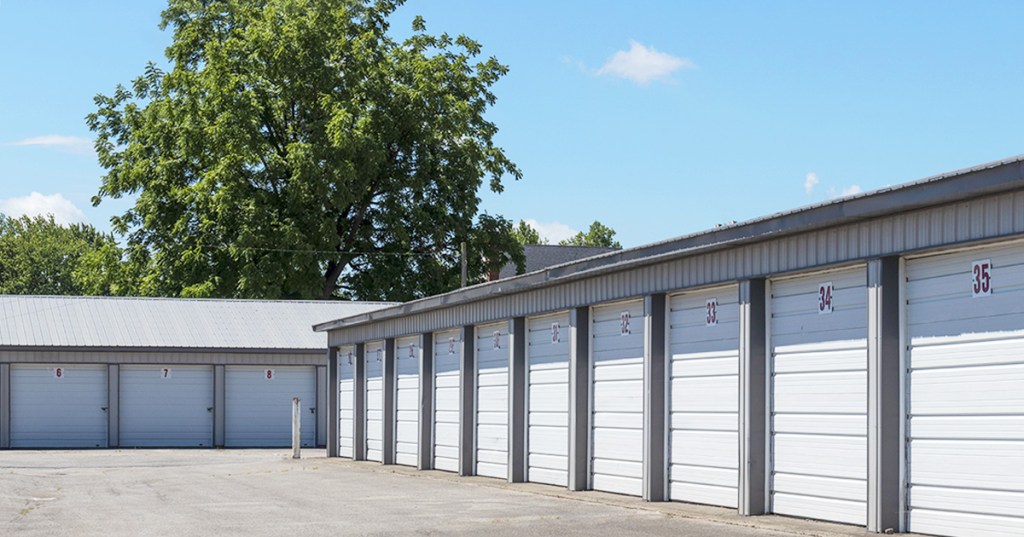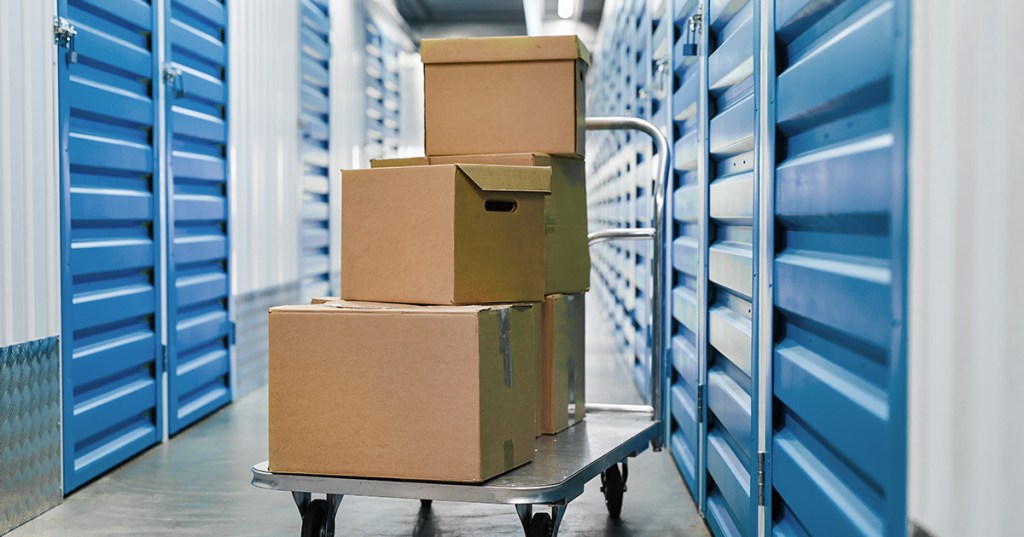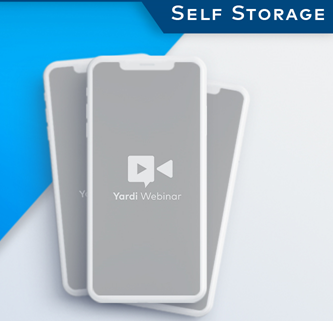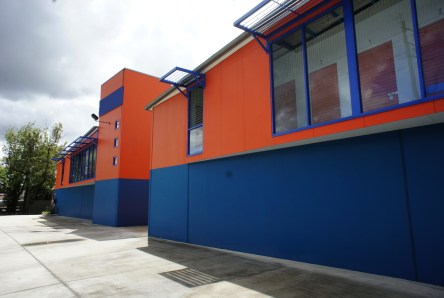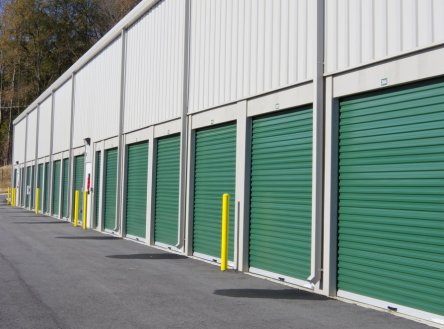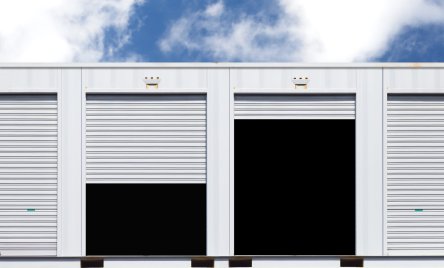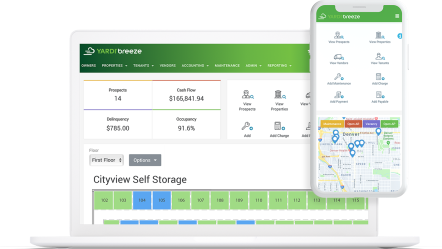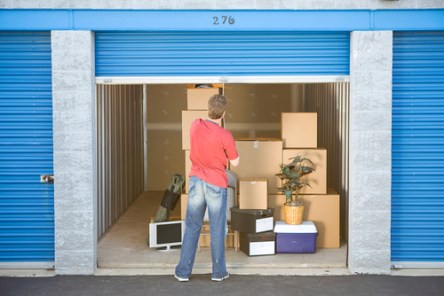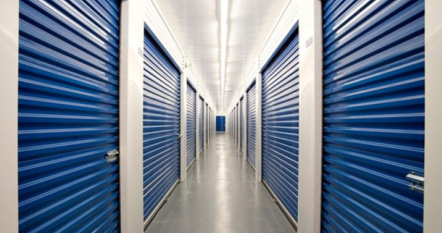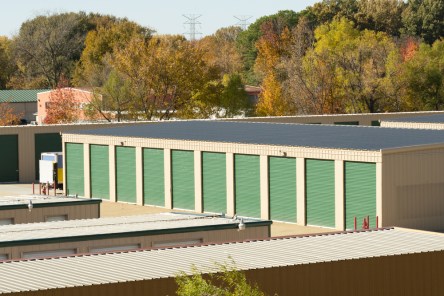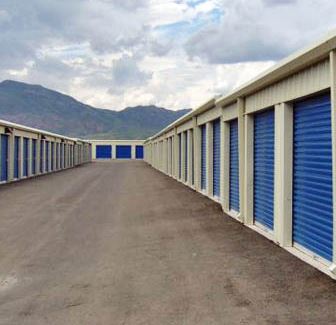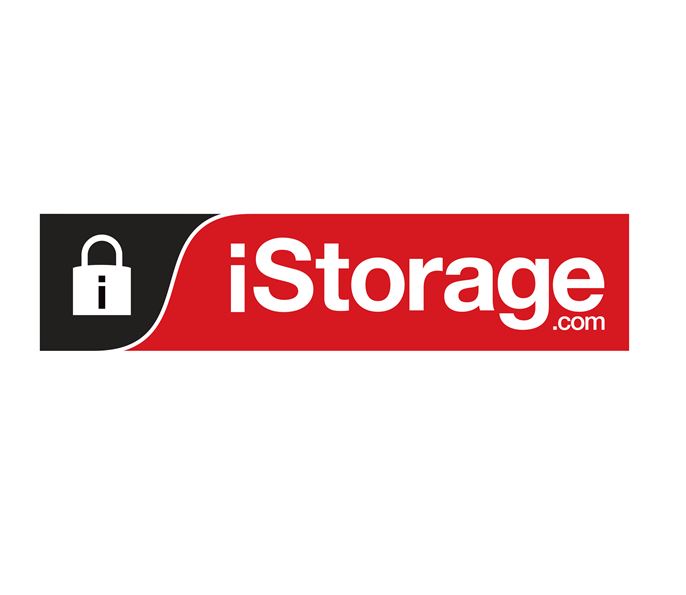The self storage sector continues to weather economic conditions that are likely to become more challenging in the near term, attendees of a webinar presented this week by Yardi Matrix learned. “There are several headwinds that might be getting a bit stronger,” said Jeff Adler, vice president of Yardi Matrix, during the Wednesday presentation. Supply chain disruptions, a tight labor market and inflationary pressure, in addition to the geopolitical tensions between Russia and Ukraine, will all slow economic growth in the U.S., Adler said. A recording of the webinar and presentation materials are now available for download. However, despite the potential of a looming recession that Adler expects will arise by late 2024, the overall outlook for the self storage sector is healthy at present. “The outlook for self storage remains optimistic given persistent demand and a slow supply response. We anticipate growth will continue, but moderate,” Adler said. “Investor interest is incredible in the sector, given its performance and defensive nature, which has proven itself out.” Matrix analysts expect that self storage street rates will continue to grow in 2021, just at a more modest rate. Additional high level takeaways from the webinar include: Street rate growth will continue to be highest in favored migration areas, such as the Sunbelt and mountainous areas of the WestDriving forces of demand will continue, including: people are still relocating, just at a slower rate; Americans have accumulated “stuff” during the pandemic that needs to be stored; and self storage remains the cheapest way to store accumulated possessions Self storage street rates changed little sequentially in January, reflective of positive trends in the industry, and rents remain well above trend on a year-over-year basis, according to the latest Yardi® Matrix National Self Storage Monthly report. Year-over-year rent...
Storage Stays Strong
New Matrix Report
Despite a slight seasonal dip in occupancy, the self storage sector is beginning the year with a continuation of the strong fundamentals that fueled its success in 2021. Self storage street rates changed little sequentially in January, reflective of positive trends in the industry, and rents remain well above trend on a year-over-year basis, according to the latest Yardi® Matrix National Self Storage Monthly report. Street rates for 10×10 non-climate-controlled (NON CC) units were unchanged at $128 in January. National street rates for 10×10 climate-controlled (CC) units decreased by $1 in January to $145. Year-over-year, street rates for 10×10 NON CC units grew 7.6 percent in January, while rates for 10×10 CC units grew 7.4 percent. “Operators report that occupancy rates have dipped slightly as move-outs have increased in recent months, but that is not worrisome because properties were unusually full going into the traditional winter lull,” say Matrix analysts. Year-over-year rent growth remains positive in all major metros, with 11 of the top 32 metros at 10 percent or more growth and 25 of the top 32 at 5 percent or more growth for NON CC units. Rent increases continue to be highest in the Sun Belt and the Southwest, with demand fueling notable jumps in Texas, Florida and the Carolinas. “Rates are holding firmer than historically is the case” in the winter, said John Good, CEO of NexPoint Storage Partners, during an industry webinar. Yardi Matrix tracks a total of 3,831 self storage properties nationwide in various stages of development — including 731 under construction, 1,287 planned and 520 prospective properties. Matrix also maintains operational profiles for 27,298 completed self storage facilities across the United States, bringing the total data set to 31,129. Learn more about the state of the self storage...
Self Storage Update
From Yardi Matrix
Street rates for self storage properties are coming off record-high gains in 2021, and experts are optimistic the sector will continue to perform well in 2022, according to the latest National Self Storage Monthly Report from Yardi® Matrix. Year-over-year, national rates for 10×10 non-climate-controlled (NON CC) units increased 6.7 percent in December. Rates for 10×10 climate-controlled (CC) units increased 7.4 percent. However, month-over-month, street rates for 10×10 NON CC units declined nationally by $1 to $127 in December. National street rates for 10×10 CC units declined by $1 for the third straight month to $145. While performance is dropping back from major gains made during the summer, the growth rates are well ahead of where they were in December 2020, when national year-over-year increases were between 2-4 percent for all unit types. The reasons for optimism include the traditional “4Ds” of self storage demand: death, divorce, dislocation and disaster. Owners/managers see demand not only from those traditional drivers, but from two new Ds: decluttering and distribution/business demand. Executives who participated in a panel at the recent KeyBanc Capital Markets 2022 Self Storage Investor Forum all were optimistic about demand, rent growth and capital trends in the year ahead. One commented: “As we look back on 2021 I consider it the greatest year to date in the storage industry. 2022 will be a good year for our business.” Most operators will start spring leasing season with exceptionally high occupancy rates, giving them pricing power to increase street rates and bring existing leases up to the new market rates. Although a repeat of 2021’s 8.5 percent rate growth for 10×10 non-climate-controlled units is unlikely, Matrix analysts expect strong overall growth in 2022. Yardi Matrix tracks a total of 3,022 self storage properties nationwide in various stages...
Changing Demands
Self Storage Adapts
The self storage industry has remained relatively strong in the wake of the pandemic. In addition to its traditional roles — during moving and to supplement lack of space at home — people who never used the service before needed space to store items, and for a wide variety of reasons. Yardi’s StorageCafe division has been keeping track of these trends and assessing the future of the self storage industry. Self storage facilities stayed open during the pandemic, responding to a myriad of new demands. There was help for people and businesses in transition and long-term solutions for online retailers and anyone experiencing cramped living conditions. Facilities also adapted quickly, introducing procedures that not only address hygiene requirements but also promote efficiency — and development of them has continued, in line with current demands and trends. Storage’s increasingly diverse customer base The storage sector’s customer base became more diverse. People who had to downsize, perhaps moving to the suburbs, joined the cohort of Americans who move house more habitually. Self storage has been on hand with a place for their belongings until they decide what to do with them. Then there were the college kids no longer on campus and those who needed to return to family households to assist with childcare or with elderly parents — they all needed space for excess belongings. New businesses and ways to run them When businesses closed physical offices, many moved furniture and filing cabinets into a storage unit. Retailers who needed a place to keep their stock did the same — finding it provided more flexibility than warehousing — while transitioning to selling online. Many people had to make home offices, triggering a need to store displaced items outside the house. In addition, the pandemic caused...
Self Storage Continues to Soar
Analysts expect another 18-24 months of strong performance
The ongoing strength of the self storage industry continues to impress analysts from Yardi Matrix, the industry’s leading provider of real estate data. They presented a positive outlook for the sector in a webinar held Wednesday, Sept. 1. (View the recording.) Continued migration from all parts of the country is an ongoing positive for the industry. Street rates are up across the board, with all unit sizes, vintages and property ratings experiencing strong increases. Newer facilities and highly rated facilities, however, have seen their rates accelerate faster than competitors. “If people are moving anywhere, that’s a really good thing for self storage,” said Chris Nebenzahl, editorial director for Yardi Matrix. And Americans have been moving a lot recently – a Matrix estimate puts the amount of relocation at 6 years’ worth of moves condensed into a year and a half. But as the pandemic drags on, it has also been possible to pinpoint some of the additional reasons that demand for storage units, especially medium and large units, remains high. They include: As people transitioned to working from home or educating children at home, they used storage to remove furniture from their households to create space for those activities.Demand for socially distanced outdoor activities prompted the need for storage for vehicles like motorcycles, boats and ATVs. (Next year, Matrix will introduce reporting specifically on storage facilities that handle RVs and boats.)Both temporary and permanent moves prompted renters and homeowners to store items while relocating.Business use of storage units to aid with inventory management during a period of disrupted consumer behavior. Gateway markets, which were already seeing outbound migration pre-pandemic, saw the largest gaps between improved self storage performance and struggling performance of multifamily. Between March 2020 and July of 2021, street rates grew 24 percent in Chicago while multifamily rents edged up just one percent. And in Manhattan, street rates were up eight percent while multifamily rents dropped nearly nine percent. As street rates continue to rise month after month, investors and owners are wondering how long these gains can last. In the near term, they show no signs of abating. “The demand is there. We are seeing record growth rates. This is an opportunity for the self storage industry to make hay while the sun shines, but we think this is going to continue for another 18-24 months,” Nebenzahl said. Learn more about the self storage industry’s success in the latest Matrix National Self Storage...
Smooth Sailing for Self Storage
For next 18-24 months
As Americans continue to move about the country in the aftermath of the COVID-19 pandemic, they’re often downsizing, temporarily relocating, or electing not to take all of their possessions along with them. The exodus of renters from high priced gateway cities has been beneficial for the self storage market, and Yardi Matrix vice president Jeff Adler is carefully confident that strong demand for storage units will continue for the next 18 to 24 months. “I’m cautiously optimistic, but wouldn’t say wildly optimistic, about the sector near term,” Adler said during a Self Storage National Outlook webinar presented on March 24. The webinar also included an overview of the national economy, potential for inflation, employment trends and other factors. It’s available to view online. For the next few months, renters may be moving back to cities that they left a year ago to resume in-office employment or making final decisions about whether to stay in a new city they tried out while escaping an urban lifestyle in 2020. Those moves will likely impact storage positively. Although vacancy across the country’s largest office markets continues to inch upwards compared to Q1 2020, increases in office sale and rent prices show investors have not lost any confidence in the strength of both traditional and up-and-coming markets. For example, the latest national office market report released by CommercialEdge found that, despite pandemic challenges, Nashville saw a year-over-year increase of nearly 6% in office lease rates, which rested at $31.06 per square foot — coming up closely behind San Diego office space, which averaged $39.44 per square foot, following a modest increase of 0.8% compared to February 2020. Self storage demand could be further bolstered if there is a second wave of moves out of higher-cost real estate markets, Adler shared. Such moves will be contingent on employment trends as the country recovers from the year-long pandemic. So far, migration is flowing from California to states like Colorado, Texas and Arizona, and out of New York to states like Florida and North Carolina. Utah and Idaho are also experiencing a high volume of new residents. “As long as there is movement of people, storage tends to do quite well. Continuing moves would keep the demand for storage high,” Adler said. But at some point, pandemic-influenced demand is expected to subside. National street rates for 10×10 non-climate-controlled (NON-CC) units increased by 2.6% compared to February 2020, and rates for 10×10 climate-controlled (CC) units grew by 3.1% over last year. While street rates nationwide saw substantial growth year-over-year, rates for both unit types remained flat month-over-month. Along with the industrial sector, self storage is a bright spot for real estate investors. Focused on short-term returns, however, they are mainly electing to purchase existing properties rather than sink time into ground-up development. Deal velocity picked up at the end of 2020 and 2021 is expected to be a record year for self storage transactions. “Relative to industrial, which is very pricey, and other asset classes, self storage as an investment class is very attractive and that’s driving a lot of institutional investor interest,” Adler said. Consistent street rate performance and ease of management are both positives for investors. The only downside for some markets is large supply pipelines, which could push down prices as they come online. Nationwide, Yardi Matrix tracks a total of 2,237 self storage properties in various stages of development: 597 under construction, 1,201 planned and 439 prospective properties. The national new-supply pipeline as a percent of existing stock increased 0.1% month-over-month in February, and the share of existing projects in planning or under construction stages accounted for 8.4% of existing inventory. Matrix also maintains operational profiles for 26,534 completed self storage facilities across the United States, bringing the total data set to...
Surviving + Thriving
Self Storage Sector Stays Resilient
During every Yardi Matrix webinar, vice president and presenter Jeff Adler shares the big picture of current economic conditions and conundrums – also known as the Yardi Matrix House View. Here’s how the view is looking from the Matrix vantage point these days: “We had a deep recession. We’re in the middle of a recovery. That recovery is likely to be choppy,” summarized Adler to close out Thursday’s Matrix update on the self storage sector. A recording of the presentation is now available, and you can view that here. But for those invested or interested in the self storage market, the seas are not looking quite so rough. Of all commercial real estate sectors, storage had a brief negative impact from COVID-19’s rise in the U.S., and then quickly recovered. “Storage is actually doing quite well,” said Chris Nebenzahl, editorial director for Yardi Matrix. “The demand for storage has been consistent and is stronger than some of the other asset classes in commercial real estate.” Key factors for the sector’s resiliency include: Relocations and population migration. Americans are leaving congested big cities like New York and Los Angeles for second-tier markets where they have more space. Residential volatility. For example, college students have faced ever-changing mandates about whether they would resume classes in person and online, prompting quick moves that often involve a need for storage. Economic hardship. Job losses for millions of Americans are contributing to relocations and downsizing. According to a Pew Research Center Survey, roughly one in five U.S. adults say they have either changed their residence due to the pandemic or know someone who did. The proof of sustained demand for storage is in the street rates, particularly for the non-climate-controlled category. Month-over-month rates reported for August showed that national...
Self Storage Outlook
SSA Webinar with Yardi Matrix
Self storage is still considered among the most stable real estate sectors during rocky economic times, but it is not immune from the COVID-19 crisis, attendees of the May 19 SSA Webinar presented by Yardi Matrix experts learned. “Under the best of circumstances, and short of a medical solution, recovery is going to be partial and slow,” said Jeff Adler, vice president of Yardi Matrix, at the start of the presentation. Adler and Chris Nebenzahl, institutional research manager for Matrix, presented the current outlook for self storage as it navigates changing tides. If you missed it, find the presentation materials and a recording of the session. While the industry looked strong in March, things shifted in April. National street rates for 10×10 non climate controlled (CC) units fell 2.6 percent, and rates for 10×10 CC units fell 6 percent. That was the largest decline in more than three years. The impact was nearly universal, as street rates for non-CC units fell in 97 percent of the major markets tracked by Yardi Matrix, and CC units saw declines in every market tracked. Only Raleigh-Durham and Portland, Ore. saw non-CC street rates drop less than in previous months, and Phoenix stayed completely flat (see slide at left). Nationwide, Yardi Matrix tracks a total of 2,209 self storage properties in various stages of development, comprising 593 under construction, 1,172 planned and 444 prospective properties. Matrix also maintains operational profiles for 25,914 operating self storage businesses, bringing the total data set to 28,123. The COVID-19 crisis has yet to slow self storage development, however, as properties under construction or in the planning stages account for 9 percent of the market in April, a 20-basis-point increase over March. That’s expected to change in the coming months. “We expect...
Self Storage Outlook
From Yardi Matrix
The Yardi Matrix research team delivered an insightful presentation on the state of the national self storage market on March 31, with one of the primary themes being the impact that the COVID-19 pandemic may have on the industry. Though the ultimate result of this unprecedented situation will roll out in the coming months across all real estate sectors, early indicators suggest that self storage investments may be equipped to weather the storm, the Matrix team reported. Miss the presentation? No problem, you can find the recording here. Jeff Adler, vice president, Yardi Matrix, delivered the hour-long market summary for a record number of Matrix webinar attendees. “From my perspective, consumer demand for self storage is stable or growing at this point in time,” Adler shared. Residential consumers who wanted to move out of storage to save money would have already done so, he commented. The greater industry risk, Adler noted, is from small retail businesses that may use self storage facilities for inventory storage/warehouses, since brick and mortar retail is extensively affected by nationwide non-essential business shutdowns. The coming weeks and months will reveal just how vulnerable such tenants might be. A key factor to watch when assessing the health of the market is business bankruptcies, shared Adler. If states and metros can bounce back quickly and rehire workers, impact will be lessened. But prolonged shutdowns could lead to greater distress and increased impact for the self storage market. From an investment perspective, major REITs have essentially halted their purchases in the self storage market for the time being, shared Jack Kern, director of institutional research for Yardi Matrix. “Nobody is moving forward (with planned transactions),” said Kern in response to a question asked on the webinar. “This may be an opportunity for...
Rate Weight
Self Storage Update
A new report from Yardi Matrix shows that elevated supply levels continue to weigh on U.S. self storage street rates, which fell 1.7% year-over-year in November 2019 for standard 10×10 non-climate-controlled units and 3% for climate-controlled units of the same size. Self storage projects under construction nationwide accounted for 9% of the total existing national inventory that month, a 20-basis-point, month-over-month increase. San Jose, Calif., and Portland, Ore., led in this category with 18.5% each, followed by Seattle, New York City and Sacramento, Calif. The month-over-month national average street rate did increase by $1 in November as new-supply pressures slowly alleviated in select markets. Strong demand for storage space reflects job growth in metros like Orlando, Fla., which added more than 54,000 jobs in 12 months and saw its self storage pipeline grow 50 basis points from October to November. Other metros with rising populations, such as Dallas, Houston, San Antonio and Austin, Texas, also have seen significant new supply over the past few years that resulted in street rate declines. The most recent Yardi Matrix monthly supply and rate recap incorporates an enhanced approach for calculating projects under construction and planned as a percent of total existing inventory. “Compared to our old method, the new methodology provides a more complete picture of the development pipeline and results in a minor increase or decrease of the development pipeline of many markets,” the report says. See that new methodology put into action in the Yardi Matrix national self storage report for December...
Top Notch Tulsa
Self-Storage Market Growth
When it comes to the typical self-storage customer, renters living in tiny metropolitan apartments come to mind. But Tulsa, Oklahoma breaks the mold. The self-storage market thrives in this spacious rural town. Let’s take a look at why, and what the future may hold for cozy Tulsa. Why is Tulsa a Hot Spot for Self-Storage? Tulsa is a spacious town with large apartments and even larger homes. Why do residents crave extra space? An Amazon distribution center recently opened in the area, boosting employment for locals but also drawing in new residents who may be in need of more space. Amazon isn’t the only new employer. Though trade wars have stalled job growth, several initiatives already in the pipeline make the city’s economic prospects for 2019/2020 quite favorable. Tulsa is also a city for outdoor adventurers. Nestled along the Arkansas River, locals enjoy getting out on the water. Kayaks, canoes, stand up paddle boards and massive inflatables take up lots of space. The nearby Turkey Mountain Urban Wilderness Area is a popular spot for mountain biking and horseback riding. Rather than filling garages and basements, Tulsans take advantage of affordable self-storage units. (More on unit affordability below.) The affinity with nature bears a dark side. Tulsa is prone to tornados. After devastating storms, families may salvage what is left and place it in storage units until their homes are reconstructed. Tulsa Self-Storage Market, Grown and Growing In Q3 2019, Yardi Matrix data revealed that the year-over-year change in Tulsa storage street rates was positive for most unit types. That’s excellent news, as most major cities in the region experienced a decline. What’s even more impressive is that this growth has happened without price hikes. Tulsa self-storage facilities have some of the lowest rental rates in the nation....
A Match Made in Heaven
Self Storage + Multifamily Housing
The 2020 NMHC & Kingsley Apartment Resident Preferences Survey reports that 71 percent of rural renters and 70 percent of suburban renters ranked “additional storage outside apartment” as a top interest. Many multifamily properties, however, are not equipped with storage units for renters. Self-storage facility managers can fill the gap and benefit from a steady stream of clientele—if you make the right connections. Make an offer they can’t refuse Before the turn of the millennium, additional storage wasn’t as in-demand then as it is now. As a result, many older properties weren’t constructed with storage units for renters. Even some newer properties with storage options don’t have enough to meet demand. Such properties may prove to be your valuable partners. Renters who need storage may find the additional space they need at self storage facilities in the neighborhood. The challenge is to make sure that your storage facility tops their list. You could amplify your online marketing strategy, but that could be costly and time consuming. A captive audience, through a partnership with local apartment communities, could be a much surer path to success. Think about negotiating an incentive or deal for residents in nearby apartment communities. You’re interested in predictable, long-term clients. Multifamily agents want to meet prospects’ and renters’ demands for storage space outside of the unit. There is room for both parties to benefit. “Consider approaching the apartment community with a win-win proposal without a formal monetary reward if there is not another competing storage property within proximity. Pitch your storage property as a neighborhood amenity that the community manager can promote. Only offer a referral bonus if competition forces you to do so,” advises Mark Smith, Director of Marketing with Yardi. He continues, “Storage operators should consider (and continually re-evaluate) their new customer acquisition costs. Make sure that your referral bonus agreement with an apartment community is in line with your normal acquisition costs.” Benefit from verified clients Most multifamily properties vet their residents before allowing them to sign a lease. A verification of employment history, good credit standing, and background checks are quite common. In contrast, very few self-storage facilities require an in-depth approval process. When you create a relationship with an apartment community, you can benefit from their verification process. Multifamily renters go through additional steps that could in turn reduce your exposure to missed payments and other risks. You will still benefit, though, from your own due diligence. “Track all tenants that rented via referral programs and evaluate for ROI,” says Smith. “Are they tenants that have paid their bills and stayed long enough to provide a positive revenue stream, or are you better off terminating the agreement with the apartment community?” Put your best foot forward To secure your position as their preferred vendor, clearly detail what differentiates you from the competition. You then have a platform to confidently state your price because you have demonstrated the value that you can offer to their renters. There are a few key features that renters want in off-site storage. If you offer such features, be sure to highlight them in your proposal: Security In an ideal world, renters would safely store their belongings in their apartment. But with limited space, that isn’t an option. They rely on you to provide additional space that is also secure. Keyless access via a smartphone app or personalized keycodes are popular with renters. (Some use similar technology to access their apartments.) By implementing such tech, you can offer a secure way to access units without the burdens and risks of physical keys. Most renters expect security cameras and gated entry. Offering 24/7 staff availability (or at least extended office hours) adds an appealing layer of security and reassurance during emergencies or other issues. Ease of Use While renters want secure self-storage, they want to access it on demand. This is another place where keyless entry places you...
Tough Times Ahead?
Matrix Self Storage Update
New deliveries continue to tamp down street rates in almost all U.S. self storage markets. Ground-up projects in secondary markets plus conversions and expansions in highly regulated markets are elevating supply levels, putting the industry through a “rough slog” for the foreseeable future, according to a new report from Yardi® Matrix. In September 2019, street rates decreased in about 85% of the top markets tracked by Yardi Matrix compared to September 2018. Year-over-year street rates slipped by 2.5% for standard 10×10 non-climate-controlled units, with similar-size climate-controlled units falling even more sharply (3.7%). “Deliveries are expected to remain elevated, pushing down pricing for many operators and increasing the need for improved performance through tightened operating costs and better efficiency,” says the report, which is based on a data set of more than 27,500 completed and developing self storage properties. Nationwide, self storage properties under construction or in the planning stages accounted for 9.4% of the total stock in September, a 10-basis-point increase over the previous month. Such properties accounted for over 20% of total stock in Nashville, Tenn., and Portland, Ore., with Seattle not far behind. Which three metros had positive annual street rate performance in September? Where were the highest and lowest asking rates? Why is development booming in New York City? Get these answers, and much more, in the self storage supply and rate recap for October 2019, which is available for...
Self Storage Update
High Supply a Mixed Blessing
Will too much of a good thing hurt the U.S. self storage industry? Possibly, but elevated supply is just one uncertainty surrounding the sector, which was the subject of a recent update presented by Yardi Matrix. Those who invest, manage and develop self storage properties have some positive economic data on their side, such as solid gross domestic product growth, low inflation and rising wages. In another encouraging sign, capital for self storage investment has become abundant as major commercial real estate firms seek to diversify their portfolios. While nationwide delivery of new supply in 2019 will trail last year’s total, growth will “taper off but not fall off a cliff” over the next few years and robust expansion remains the rule, according to Jeff Adler, Yardi Matrix vice president and general manager, who presented the update with Chris Nebenzahl, institutional research manager. Less favorable indicators include the inverted yield curve, international trade conflicts and slowing economic growth in Europe and China. These are among the key factors that elevate the risk of a U.S. recession occurring by mid-2021, Adler said. Key Trends Demand drivers for self storage properties mirror the country’s larger job, population and domestic migration trends: People and employers are leaving gateway markets like New York City, Chicago and Los Angeles for metros in the Southeast and Southwest with lower business and living costs, plus secondary tech markets. That movement has put self storage space in high demand in metros like Dallas, Orlando, Fla., Phoenix, Las Vegas and Charlotte, N.C. These trends shape a short-term need for self storage space, but absorption of existing supply and projects in the pipeline will eventually depress street rates in most markets, with popular millennial destinations like Charleston, S.C., Nashville, Tenn., Denver, Seattle, Orlando and...
Self-Storage Skills
Keeping Customers Happy
Self-storage is in high demand these days, not just by renters but also by homeowners who need a place to keep some things for a time. About 1 in every 11 households rents a storage unit, according to research from MJ Partners. Self-storage can provide security, convenience, and it’s often very cost-effective. To be competitive and make the best return on investment, storage facility owners need to know how to keep their customers loyal and happy. Storage renters want value for money, but they also have other preferences which may not be so obvious. Fortunately, the Self Storage Association’s most recent Demand Study provides useful data about the features that renters consider important. Easy Come, Easy Go Convenience is a top priority for most self-storage renters. The ability to access a unit at any time is crucial for 57% of respondents, indicating their desire to be in full control of their stuff and to get it back whenever it suits them. Moreover, 24% would pay extra for this feature. Also high on the list, is the ability to drive up to a unit, letting them load and unload quickly. 54% of renters value the location’s accessibility by car, with 20% of them stating they were willing to spend additional money on it. While ease of access is important, so is security. Implementing 24/7 access can mean installing extra security measures against unauthorized entry, but such investments are usually worthwhile. Approximately 30% of all Millennial, Gen-X, and Boomer renters are willing to pay extra for electronic gates at the entrance. If a facility doesn’t already have this, installing high quality equipment is advisable to prevent theft, 37% of renters consider that security alarms essential, and 15% are willing to pay a bit extra for such...
Storage Going Cold?
New Yardi Matrix Report
Headwinds are on the rise in the U.S. self storage sector, even as self storage facility developers continue to break ground on new projects amid favorable economic and demographic dynamics. The implications of high supply levels are the focus of a new report from Yardi Matrix. Street rates plummeted in July 2019, dropping by 2.5% year-over-year for standard 10×10 non climate controlled units and 4.3% for similar-size climate controlled units. All told, annual street rate performance was negative in 89% of the top metros that Yardi Matrix tracks, with heavily developed markets like Charleston, S.C., and Raleigh-Durham, N.C. experiencing major declines. “Compared to July 2018, street rates have deteriorated even in markets with strong demand and limited new supply, such as large metros on the West Coast,” the report says. Meanwhile, development activity intensified in about 40% of the top markets as of August. How are storage operators changing their operating strategy to cope in this environment? Find out in the new Yardi Matrix national self storage report for August 2019. The report compiles data from more than 27,000 U.S. self storage projects that are completed or in various stages of...
Simple Software
Just for Self-Storage
At ISS World Expo in Las Vegas this week, one of the largest conferences for self-storage professionals, Yardi Breeze Self Storage made its debut. The theme of the conference focused on perfecting the self-storage customer service experience, and Yardi’s latest product enables smaller operators of storage facilities to do just that. Yardi Breeze Self Storage is refreshingly simple software for self storage property management. It’s designed to help owners and operators with smaller portfolios increase efficiency, reduce IT headaches and save time and money. Self storage owners, investors and managers can use the innovative tools built into Yardi Breeze Self Storage to market, lease and manage their facilities from any device. These tools include: Full accounting: manage operations and financials in one place Integrated marketing: fill vacant units faster with syndicated online listings Automated reporting: generate and share financial reports via email or secure portal Online payments and maintenance: streamline collecting rent and fulfilling work orders Tenant communications: create, send and track emails and texts to renters A simple online setup process lets users start working in Yardi Breeze Self Storage right away; no lengthy implementation process is required. Unlimited live chat support is included. “Yardi Breeze Self Storage is easy to set up and simple to use. And amazing support is always there when I need it,” said Laura Van Tassel, self storage operations manager at Stuff It Storage, LLC and an early adopter of the new product. As operators’ needs expand, there is a growth path to the Yardi Self Storage Suite for larger portfolios. “Yardi now offers a range of software options for self storage businesses of all sizes. Yardi Breeze Self Storage builds on the success of our Yardi Breeze property management platform for smaller portfolios to deliver an easy...
Self Storage Update
From Yardi Matrix
The U.S. self storage industry mirrors the conditions in the larger economy, thriving for the most part amid some potential headwinds, according to a recent update presented by Jeff Adler and David Dent. They are vice president and senior real estate market analyst, respectively, for Yardi Matrix. Employment numbers and the overall economy are strong, with gains concentrated in lower cost locations like Nevada, Arizona and Florida. As a result, new self storage supply is strongest in these domestic migration destinations. Millennial favorites like Portland, Ore., Nashville, Tenn., Orlando, Fla., and Seattle, are similarly enjoying healthy demand for self storage facilities, as are underpenetrated metros such as New York City, Boston, Philadelphia and Chicago. Forces that could impact the self storage industry adversely include the possibility of an inverted yield curve—when long-term debt instruments yield less than short-term debt instruments—and international trade uncertainties. But “sharpshooters” willing to research deeply can still prosper, Adler and Dent said. Opportunities could arise from facilities left vacant by retail bankruptcies; local supply, demand penetration factors; continued penetration in gateway markets; and underserved pockets of high in-migration secondary markets. Storage facility owners might gain opportunities to raise rents in markets with low storage-to-apartment-cost ratios such as Austin, Texas, and California’s Inland Empire. In addition, the self storage industry is broadening its service suite with automation and technology. Available or proposed enhancements include fully automated leasing, enhanced gate systems and other security, co-warehousing that uses vacant storage space for small industrial purposes, and climate controlled storage for wine collections and other temperature-sensitive possessions. As the overall economy approaches a soft landing in the downside of the current cycle, the self storage sector “is still attractive in the long term if you have the financial wherewithal to ride through” potential adverse...
Self Storage Portrait...
New Matrix Report
A new report from Yardi Matrix illustrates how the self storage industry’s performance mirrors employment growth and population gains. Development activity for self storage space is highest in metros such as Portland, Ore., Nashville, Tenn., Seattle and Orlando, Fla., where corporate expansions and relocations, along with college student enrollment and multifamily development, are driving demand. Nationwide, units under construction and in the planning stages account for 9.4% of inventory. The report also documents strong development activity in Boston and New York City, which are historically undersupplied markets. Street rates for self storage units declined slightly nationwide in December a normal seasonal occurrence. In addition, the report notes, “New projects coming online over the past few months continued to weigh on rent growth at the national level, albeit at a much slower pace compared to the previous month.” Yardi Matrix tracks nearly 2,000 self storage development projects in the pipeline and maintains operational profiles on more than 24,600 completed properties. Read the full supply and rent recap for January 2019. Learn more about Yardi self storage...
Storage Switch Up
Toronto's Second Closet
Second Closet, a start-up based in Toronto, is revolutionizing the storage industry. The company was created on an operating model where users only pay for what they store, not a fixed storage locker price. With prices starting as low as $3/month, customers can have a virtual second closet to store seasonal, personal and unused items. The company picks up items for storage and delivers them back when clients need them again. With the rising population and demand for space in Toronto, people are struggling to find extra storage. These services are transforming the storage industry and addressing prominent issues of the moving pains associated with city living. This year, Second Closet raised $2 million from investment company MIG Group, helping to fully launch the business and make the entire storage process convenient and efficient.We spoke to founder and CEO, Mark Ang for more details. He cofounded the company with his brother, David. Why is now the time for your company to exist? Ang: There’s going to be 10B people in the world by 2050. They aren’t going to be flooding the suburbs, they’ll gravitate to urban areas provided there’s housing available. At the same time, we’re not seeing condominium developments slow down. For cities like Toronto, it’s easy to look at a city like New York to get a glimpse of what life could and likely will be like when things get more densely populated. Since housing prices outpace personal income, condo developers are simply building smaller units so that they still achieve the optimal price per square foot but the nominal price of the unit as a whole is within financial reach. That basically creates a whole lot of shoe boxes in big urban cities. I think we’re position well to help people...
Self Storage Update
From Yardi Matrix
The self storage industry has been strong over the last several years, with economic growth creating new households and driving demand. Can this pace continue or will the recent supply surge outpace demand? That question formed the basis of a recent web presentation by Jeff Adler and David Dent, vice president and senior real estate market analyst, respectively, for Yardi Matrix. Their discussion focused on four areas: Macroeconomic Outlook The U.S. economy is in very good shape, Adler and Dent reported, with gross domestic product growing, inflation under control, and a tight labor market “pulling people off the sidelines,” although trade and immigration policies could brake the growth. Their research reveals that millennials and Baby Boomers are leaving big cities such as New York, Los Angeles, Chicago and Miami in favor of smaller, lower-cost cities with concentrations of intellectual capital work, which in turn drives storage demand. Destination metros include Dallas-Fort Worth, Tampa, Fla., Atlanta and Charlotte, N.C., along with retirement favorites such as Las Vegas and smaller mountain metros in the Appalachians and the Rockies. However, rental market fundamentals are faltering, with only 12 of 133 markets studied by Yardi Matrix showing year-over-year rent increases in September 2018, versus as many as 41 in previous years. Profile of Current Supply and Demand Domestic migration patterns have made Las Vegas, Tampa, Phoenix, Orlando. Fla., and Columbus, Ohio, the most attractive metros for self storage providers, Adler and Dent reported. The national average of self storage projects under construction and planned as a percent of existing inventory is 9.5%. Portland, Ore., Nashville, Tenn., Orlando, Boston and Seattle have the highest percentages. Approximately half of storage customers are in the process of moving while the other half are long-term users. Adler and Dent noted that approximately...
Self Storage Data
Yardi Matrix Expands
Yardi Matrix has expanded its self storage coverage to 125 markets, up from 99. This total represents 26,535 properties, of which 1,398 are some form of new supply, and 1.4 billion square feet of space and encompasses 83% of the U.S. population. The addition of 26 markets produces the self sector’s most comprehensive market intelligence and competitive analysis source. Yardi Matrix also covers multifamily and office portfolios. “Matrix is now the largest data set for market intelligence and competitive analysis in the self storage sector. The recent expansion is the latest example of Yardi’s commitment to providing the industry’s leading tools for identifying and executing development, management and underwriting deals,” said Jeff Adler, vice president of Yardi Matrix. Yardi Matrix is a business development and asset management tool for investment professionals, equity investors, lenders, and property managers who underwrite and manage investments in commercial real estate. Its resources include true ownership, in-place debt, and rental and sales history data, along with a new supply pipeline that includes 1,398 tracked projects. Yardi Matrix covers multifamily, industrial and office property types in addition to self storage. Email [email protected], call 480-663-1149 or visit yardimatrix.com to learn...
Honored for Innovation...
Yardi’s Self Storage Product
Yardi has been recognized for its self-storage technology platform by Inside Self-Storage, an industry publication for storage providers. The company won the Best Technology Innovation category in the 2015 Best of Business awards. It’s the latest honor for the company’s move into the self-storage business, which began in early 2014 with the acquisition of Salt Lake City-based Centershift. Today, that product is part of Yardi’s Genesis2 offering, targeted directly to self-storage providers. Genesis2 is the first single platform, device-agnostic, full suite solution, complete with robust accounting capability and customer management portals. “This is just the tip of the iceberg, from an innovation standpoint, for Yardi in the self-storage market,” said Mark Smith, Director of Self Storage Marketing for Yardi. The company also offers platforms for the industry’s largest storage providers. Yardi Genesis2 is designed for the property manager who wears every hat. Typically managing a small to mid-sized portfolio, they need comprehensive, mobile solution that makes juggling multiple tasks easier. Lauded features include best-practice workflows, all-one-functionality, maintenance, insurance, payment processing, and tenant services. Yardi Genesis2 is available today, and you can get more information...
iStorage
Chooses Yardi Store Enterprise
Yardi® announced today that it has been selected by iStorage® to provide the management software for its self-storage portfolio. With over 65 properties in ten states and several new acquisitions under contract, iStorage needed an innovative and flexible system that provided time-saving controls to support their aggressive growth. After an extensive due diligence period comparing multiple systems, iStorage chose Yardi Store Enterprise™ and completed implementation of the platform in March 2015. As a rapidly growing business, iStorage needed to transition to their new system quickly. To ensure iStorage was up and running smoothly, cutover from their legacy system was successfully completed with expert support from the dedicated Yardi team in just three days. The implementation included extensive testing and custom development through Yardi Store’s powerful API for both internal and customer-facing systems. According to Chris Harris, president of iStorage, “We chose Yardi Store Enterprise over other options because of its multi-store management capabilities, strong accrual accounting platform, customization opportunities and friendly support team. Our core system must also support our aggressive growth objectives, and Yardi Store Enterprise was the clear and obvious choice for us.” He continued, “Yardi Store Enterprise is delivering everything we need, and thanks to a smooth rollout we experienced very little business interruption. The Yardi team was there every step of the way to support a quick and efficient transition to our new system.” Yardi is delighted to welcome iStorage to its continuously growing family of clients. “It has been a pleasure to partner with iStorage. They have assembled a world-class team that sees the big picture and strives to do everything the right way for their customers. Yardi looks forward to helping them achieve their goals, as we continue to offer a product stack that will keep iStorage —...
Self-Storage
High Demand, Limited Supply
The cat is out of the bag. Self-storage is a hot industry with hefty returns and minimal operating costs. If you haven’t explored the possibilities in this sneaky big market, you may be running out of time. Vacancy rates have gradually declined in the past seven years as rentals proved to be a more favorable option for young adults, empty nesters, and those facing financial challenges during and after the recession. Even as the economy regains its health, self-storage continues to do well as people relocate for work or for more comfortable living. By the end of 2014, self-storage occupancy reached a historic high of 90 percent. Yardi client Morningstar Properties president Dave Benson weighs in, “It’s really been strong occupancies and good demand as housing comes back, as jobs come back and people start to move around a little bit,” he says. 2015 has enjoyed a great start. Morningstar Properties exceeded its capital goal for a $75 million private-equity fund that will acquire at least 10 properties. Other Yardi clients also have ambitious plans for the year. Cubesmart has begun a 36-property acquisition from Chicago-based Harrison Capital. Ernst & Young Capital Advisors spotted LifeStorage LP with $120 million in equity to expand operations across the nation. Yet as institutional investors with diverse portfolios continue to pounce on Class A opportunities within the sector, top-notch assets have become harder to find. New developments are being built prospectively, often scooped up before being marketed. Second quarter of this year, we may see the self-storage behemoth lose its fangs, at least temporarily. Cap rates are declining and new construction is slowly forthcoming. “We were seeing stabilized assets trading at 5.5 percent cap rates, where this sector doesn’t usually see rates of less than 6 percent,” reports R....

